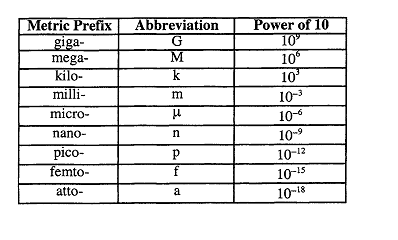A metric prefix is a shorthand
notation used to denote very large or vary small values of a basic unit as an
alternative to expressing them as powers of 10. Basic units frequently used in the biological
sciences include meters, grams, moles, and liters.Because of their simplicity, metric
prefixes have found wide application in molecular biology. The following table lists
the most frequently used prefixes and the values they represent.
notation used to denote very large or vary small values of a basic unit as an
alternative to expressing them as powers of 10. Basic units frequently used in the biological
sciences include meters, grams, moles, and liters.Because of their simplicity, metric
prefixes have found wide application in molecular biology. The following table lists
the most frequently used prefixes and the values they represent.
Metric Prefix
1 nanogram (ng) is equivalent to
1*10^-9 grams. There are, therefore, 1*10^9 nanograms per gram
(the reciprocal of 1*10^-9; 1/1*10^9 = 1*10^-9). Likewise, since
one microliter (uL) is equivalent to 1*10^-6 liters, there are
1 x 10^6 uL per liter.
1*10^-9 grams. There are, therefore, 1*10^9 nanograms per gram
(the reciprocal of 1*10^-9; 1/1*10^9 = 1*10^-9). Likewise, since
one microliter (uL) is equivalent to 1*10^-6 liters, there are
1 x 10^6 uL per liter.
When expressing quantities with metric
prefixes, the prefix is usually chosen so that the value can be
written as a number greater than 1.0 but less than 1000. For
example, it is conventional to express 0.00000005 grams as 50 ng
rather than 0.05 ug or 50,000 pg.
prefixes, the prefix is usually chosen so that the value can be
written as a number greater than 1.0 but less than 1000. For
example, it is conventional to express 0.00000005 grams as 50 ng
rather than 0.05 ug or 50,000 pg.
Reference:
Mathematics in molecular biology and biotechnology
Got something to say about this post? Leave a comment…your comments are valuable for improving the posts.
